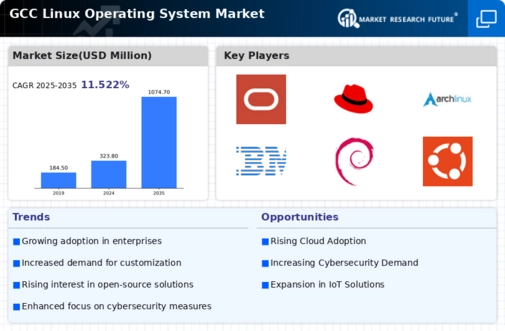The GCC Linux Operating System Market has been evolving significantly, driven by the increasing demand for open-source solutions across various sectors, including education, government, and business. This competitive landscape is characterized by a diverse range of participants, including established vendors and emerging players who are leveraging the flexibility and cost-effectiveness of Linux-based systems. The market is influenced by several factors such as the growing adoption of cloud computing, the rise of data centers, and the need for secure, scalable, and customizable operating systems. Players in this market are focused on enhancing their offerings through innovations and features that cater specifically to regional needs, which creates a dynamic environment for competition and collaboration within the GCC region.
Oracle holds a prominent position within the GCC Linux Operating System Market, recognized for its robust solutions and extensive distribution network. The company leverages its established database management capabilities, integrated with its Linux offerings, to provide seamless and efficient computing solutions to its clients. Oracle's strengths lie in its strong emphasis on security, high performance, and reliability, which cater to the specific needs of enterprise clients in the GCC. Furthermore, Oracle maintains strategic partnerships with local organizations, facilitating better market penetration and establishing a reputation for excellence in customer support. The company's focus on regional compliance and regulatory needs further enhances its appeal in the GCC region, positioning it as a trusted provider of Linux-based solutions.
Tizen, known for its versatility and lightweight framework, has established a unique presence in the GCC Linux Operating System Market. Developed primarily for Internet of Things (IoT) devices, Tizen has found traction in various smart devices, including TVs, wearables, and automotive systems. The strength of Tizen lies in its flexible architecture, which allows for seamless integration across different hardware ecosystems, making it a preferred choice among manufacturers looking to innovate in the GCC market. The company actively collaborates with local tech firms to adapt its technology for specific regional requirements, ensuring compatibility with local digital ecosystems.
While Tizen has not prominently engaged in mergers and acquisitions within the GCC, it continues to explore partnerships that can enhance its market presence and facilitate the introduction of innovative products and services tailored to the GCC audience. This strategic focus on collaboration and adaptation positions Tizen as a key player in the emerging landscape of Linux-based operating systems in the region.


















Leave a Comment